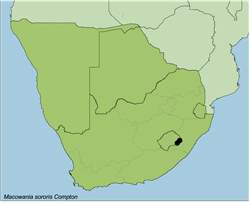Names and synonyms
Macowania sororis Compton
Type
Sister Mildred 8, East Griqualand, Mount Currie, 2133 m, 1938-04 (NBG).
Derivation of names
Macowania = after Dr. Peter MacOwan (1830-1901), botanist, director of the Cape Town Botanic Gardens, and discoverer of new species at the Cape.
sororis = sister. The type collection was made by a nun.
Diagnostic characters
Leaves woolly below, at least when young
Leaves more viscid and less glandular than in M. conferta
Capitula shortly pedunculate
Corolla tube glabrous, with few glands on the backs of the tips of the corolla lobes
Anther tails free and fimbriate
Pappus bristles about 17, equalling the corolla
Description
Dwarf, much-branched aromatic shrub forming low compact cushions. Stems densely leafy when young. Leaves imbricated/ overlapping, linear, up to 13 x 2 mm, subacute, margins strongly revolute, lower surface white-woolly, upper viscid, shining, with stout glandular hairs particularly towards the tips and on the rolled margins. Capitula solitary at the branch tips, shortly pedunculate / on short stalks. Involucre funnel-shaped, about 11 x 10 mm. Involucral bracts straw-coloured, pale brown towards the tip, lightly woolly, glandular-pubescent. Ray florets yellow, female. Disc florets hermaphrodite, corolla cylindric below, widening gradually above, glabrous. Pappus bristles about 17, subequal, the largest equalling the corolla of disc flowers, persistent. Cypsela about 3 mm long, with 10 ribs, villous.
Flowering time
Mainly November and December but sometimes to as late as April.
Distribution
Known from the Eastern Cape, Kwazulu-Natal and Lesotho. Described from the top of Mt Currie near Kokstad at 2133 m. Known only from the Drakensberg escarpment from about Qacha's Nek, near Matatiele, to Mont aux Sources. Also collected on the Matebeng Pass near Sehlabathebe in Lesotho.
Known from about 15 specimens.
Habitat
On cliffs and rock outcrops, on the basalt and dolerite overlying the Cave Sandstone in crevices on sandstone outcrops and in dry boulder-strewn streambeds, always at altitudes above 2000 m.
Notes
M. sororis is closely allied to M. conferta. M. conferta strongly resembles M. sororis from nearby Mt Currie and the Drakensberg escarpment from Qacha's Nek to Mont aux Sources. However, the leaves of M. sororis are woolly below, at least when young, are more viscid and less glandular, and the heads are shortly pedunculate. There are minor floral differences, the corolla of the disc flowers being hairy immediately below the expanded upper part in M. conferta whereas it is glabrous in M. sororis except for a few stout glands on the backs of the tips of the corolla lobes.
References
ANDERBERG, A.A. 1991. Taxonomy and phylogeny of the tribe Gnaphalieae (Asteraceae). Opera Botanica 104: 50-53.
COMPTON 1953. Plantae Novae Africanae, Macowania sororis. Journal of South African Botany 19: 114-115.
HILLIARD, O.M. & BURTT, B.L. 1976. Notes on some plants of southern Africa chiefly from Natal: V. Notes from the Royal Botanic Garden Edinburgh 34,3: 260-276.
HILLIARD, O.M. 1977. Compositae in Natal. University of Natal Press.
KESTING, D. & CLARKE, H. 2008. Botanical names, what they mean. Wild Flowers of the Cape Peninsula, 3rd revised edition. Friends of Silvermine.
POOLEY, E. 2003. Mountain Flowers. A Field guide to the Flora of the Drakensberg and Lesotho. The Flora Publications Trust.
